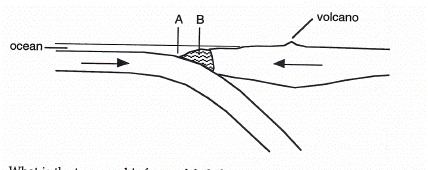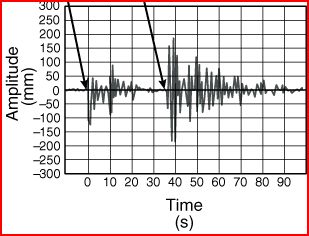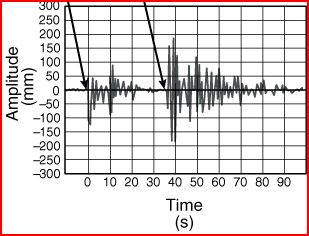Earth Science Test 2

SCI08 - Earth Science Test 2
Questions and Answers
- 1.
How do convection currents occur in the mantle? Your answer needs to have the words: cool, warm, magma, core, and crust for full credit.
- 2.
Provide one specific peice of evidence that supports the hypothesis of continental drift. Recall that there were three types of evidence:*Evidence from land features*Evidence from fossils*Evidence from climate
- 3.
Summarize the process of sea-floor spreading. In your answer you need to have the words: magma, continental crust, oceanic crust, subduction, melt, deep-ocean trench, older rock, newer rock for full credit.
- 4.
What is represented by the picture below?
- A.
Strike-slip falut
- B.
Transform boundary
- C.
Divergent boundary
- D.
Convergent boundary
Correct Answer
B. Transform boundaryExplanation
The picture represents a transform boundary. This type of boundary occurs when two tectonic plates slide past each other horizontally. Transform boundaries are characterized by intense seismic activity, as the plates grind against each other. This movement can result in earthquakes.Rate this question:
-
- 5.
Which type of fault is represented by the picture below?
- A.
Normal fault
- B.
Abnormal fault
- C.
Reverse fault
- D.
Strike-Slip fault
Correct Answer
C. Reverse faultExplanation
The picture represents a reverse fault, which is a type of fault where the hanging wall moves upward relative to the footwall. This can occur when compressional forces cause the crust to shorten and the rocks to be pushed together. In a reverse fault, the angle of the fault plane is steep, and the fault motion is primarily vertical. This type of fault is commonly associated with convergent plate boundaries, where two tectonic plates collide.Rate this question:
-
- 6.
What type of stress is represented in the image below?
- A.
Shearing
- B.
Srike-slip
- C.
Transform
- D.
Tension
Correct Answer
A. ShearingExplanation
The image likely shows a type of stress called shearing. Shearing stress occurs when two parts of a material are pushed in opposite directions parallel to each other. This type of stress can cause the material to deform or break. In the image, there may be a visible displacement or distortion of the material, indicating the presence of shearing stress. The other options, strike-slip, transform, and tension, do not specifically involve the parallel movement of material as shearing does.Rate this question:
-
- 7.
Name or describe one method of measuring earthquakes.
- 8.
At how many seconds did the P wave arrive?
Correct Answer
0
0 sec
0 secondsExplanation
The P wave arrived at 0 seconds.Rate this question:
- 9.
What is the SP lag time for the seismograph below?
Correct Answer
35 secondsExplanation
The SP lag time for the seismograph is 35 seconds. This means that there is a delay of 35 seconds between the occurrence of an earthquake or seismic event and the recording of it on the seismograph. The lag time is important for accurately determining the location and magnitude of earthquakes, as it allows for the calculation of the time it takes for seismic waves to travel from the source to the seismograph.Rate this question:
- 10.
What is the Ring of Fire and where does it form?
- 11.
Hawaii is found on the middle of the Pacific Plate. Being that it is not near faults, how did these islands formed?
Correct Answer
hot spotExplanation
The formation of the Hawaiian islands can be explained by the presence of a hot spot. A hot spot is an area of intense volcanic activity that remains stationary while the tectonic plates move above it. As the Pacific Plate moved over the hot spot, magma from the mantle rose to the surface, forming a chain of volcanic islands. This process continued over millions of years, creating the Hawaiian archipelago. Despite not being near any faults, the islands were able to form due to the unique geological activity associated with hot spots.Rate this question:
- 12.
Name one compoent of magma that determines the type of eruption that will occur.
- 13.
What type of volcano is shown below?
- 14.
Provide to a earthquake or volcanic eruption plan for a community. Be detailed and provide at least 3 different methods you would use to protect its citzens.
Quiz Review Timeline +
Our quizzes are rigorously reviewed, monitored and continuously updated by our expert board to maintain accuracy, relevance, and timeliness.
-
Current Version
-
Mar 21, 2023Quiz Edited by
ProProfs Editorial Team -
Nov 02, 2009Quiz Created by
Wrosal
- Continent Quizzes
- Easy Geography Quizzes
- Environment Quizzes
- Fictional Geography Adults Quizzes
- Land Quizzes
- Latitude And Longitude Quizzes
- Location Quizzes
- Nation Quizzes
- Nature Quizzes
- Navigation Quizzes
- Ocean Quizzes
- Physical Geography Quizzes
- Planet Quizzes
- Regional Geography Quizzes
- Remote Sensing Quizzes
- World Quizzes
- World Geography Quizzes
 Back to top
Back to top




